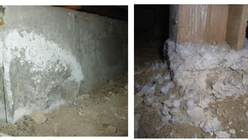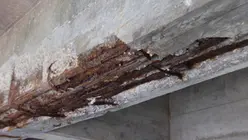Effect of carbonation on concrete and detection method
Updated: Nov 26, 2022

What is Carbonation?
Carbonation is a reaction between cement hydration products in concrete and atmospheric
carbon dioxide (CO2), which leaves steel reinforcement vulnerable to corrosion. CO2 in the atmosphere reacts with the calcium oxide in concrete to form calcium carbonate; a process called carbonation
The Carbonation process includes:
Diffusion of CO2 in the gaseous phase into the concrete pores,
Its dissolution in the aqueous film of these pores,
The dissolution of solid Ca(OH)2in the water of the pores,
The diffusion of dissolved Ca(OH)2in pore water and its reaction with the dissolved CO2
When CO2 comes into contact with water, carbonic acid (H2CO3) is formed:
CO2 + H2O ⇆ H2CO3
When the water in question is the fluid within a concrete pore, the carbonic acid will react with Portlandite to form calcium carbonate:
Ca(OH)2 + H2CO3 → CaCO3 + 2H2O
- Below is a reaction through which Calcium carbonate is is formed
Ca2+(aq) + 2(OH¯)(aq) + CO2(aq) CaCO3(s) + H2O

The process of carbonation causes contraction in the concrete, resulting in a small shrinkage.
This contraction is known as carbonation shrinkage.
The pH values of pore water in hardened concrete usually vary between 12.5 to 13.5 depending upon the alkali content in the cement. The high alkalinity of cement forms a thin protective layer around the steel reinforcement and protects it from the action of water and oxygen. As long as the steel is in the high alkaline zone, it is not going to be corroded. Such a condition is known as passivation.
The conversion of some materials in concrete to carbonate-based products is an important parameter for carbonation. Thus, the rate at which the event progresses depends on the concrete properties and environmental exposure conditions. These effects depend on the square root of the time law. The water formed during the carbonation reaction maintains the carbonation process itself. In addition, various conditions must be met for carbon dioxide to penetrate deep into the concrete. The carbonates produced as a result of the reaction by dissolving the carbon dioxide in the concrete pores reduce the pore size and the degree of interconnection between the pores and reduce the permeability. In addition, carbon dioxide can go beyond a certain point after all carbonate materials at that point have been consumed in the carbonation reaction.
Carbonation has beneficial effects on both strength and durability in unreinforced concrete by reducing the pore volume and permeability of the reinforced concrete. However, carbonation in reinforced concrete structures has a significant effect on initiating corrosion of steel. Therefore, it reduces the durability performance and life of reinforced concrete structures. After the carbonation reaction is completed, it lowers the pH value of the concrete pore water from above 13.2 to below 8.5. When this process reaches the steel level, the reduced pH causes the passive gamma-ferric oxide layer of the steel to become unstable and depacify.

failure as a result of the carbonation of concrete
Gamma ferric oxide is a thin film of Fe2 O3 formed on the surface of steel in an alkaline environment . If enough oxygen and moisture are available, section loss begins after corrosion of the steel in the concrete. Thus, the load carrying capacity of the reinforced concrete element or structure will decrease during its service life. Carbonation can seriously damage steel corrosion and long-term durability, and is effective during the design phase of a reinforced concrete structure as well as throughout the life of an existing reinforced concrete structure. In order to ensure the required service life and durability performance in concrete structures, the binder used in the concrete and the environmental impact conditions must be taken into account. The mixing ratios and the depth of the rust margin for the concrete in the building have an important contribution to obtaining the desired service life. Similarly, maintenance and repair plans must be made effective in order to extend the residual service life of existing concrete structures. This problem of concrete, determining the rate or depth of carbonation, has been studied since the late 70's. In South Africa, following the increasing possibilities of corrosion damage to concrete structures due to carbonation, attention was paid to the problem of concrete carbonation in the early 90's and hence the need to measure the durability performance and lifetime of structures in continental climate emerged. Various measurement techniques have been proposed to evaluate the depth of carbonation in concrete. Phenolphthalein solution (pH indicator) is traditionally used for carbonation depth measurements. The concrete cracked surface is sprayed with phenolphthalein spray. While the color of the non-carbonated areas turns pink, the color of the carbonated areas does not change. Carbonation event details can also be obtained using the petrographic microscope technique. Two types of samples can be used in this technique. CO 2Inspections are made on small pieces of concrete or matrix from the concrete surface exposed to . Very thin sections should be prepared to determine carbonation using a petrographic microscope. The carbonated and non-carbonate areas in the matrix will display a different color spectrum under polarized light due to different minerals. For concrete microstructural morphological observations of carbonated concrete and chemical changes of hydration products due to carbonation, the secondary mode of SEM has been used by various researchers.
Factors that affect the rate of Carbonation
Grade of Concrete
Water Cement ratio
Permeability of Concrete
Cover to the reinforcements
Ambient relate carbon dioxide
Corbondioxide concentration in the area
Surface protection
Age of the Structure
The orientation of the structure
Admixtures
Porosity of Concrete
Curing period
How to avoid Carbonation of concrete
Since the higher water-cement ratio contributes to the higher depth of carbonation, it could be controlled
Adequate curing of concrete and extended curing period will help concrete to react well, and it reduces the cracking of concrete. Adequate curing reduces the permeability of concrete and as a result rate of carbonation will reduce.
Use of admixtures to modify the pore structure and reduce the permeability of concrete.
Additives like silica fume having a higher surface area could be used to reduce the porosity of concrete.
The use of protective coatings will improve the durability of concrete and low down the carbonation process.
It has been proven that self-compacting concrete has better performance against the carbonation of concrete.
Therefore repairing of reinforcement corroded due to the carbonation of concrete could be done the same as the other repairs done when reinforcements are corroded.














Comentários